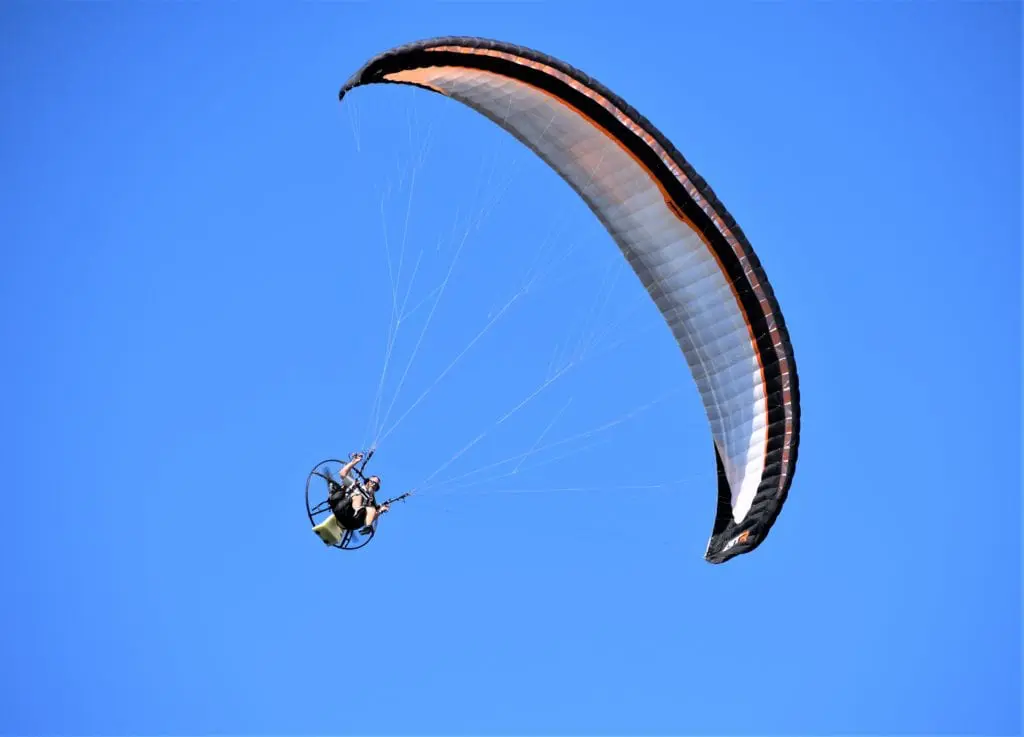Craig Carter flies along the Texas coast in his powered paraglider. He uses the paraglider to locate schools of redfish, later returning on his airboat to fish.
Story and photo by Robert Sloan for Lone Star Outdoor News
It’s called a powered paraglider, and Craig Carter, of Yoakum, not only uses it for aerial adventure but also to find fish in the surf and bays around Port O’Connor.
“It’s amazing what you can see up there,” Carter said. “The one thing that has surprised me are the numbers of really big sharks I see that are near wade-fishermen.
Something else I see pretty often are schools of redfish. They are easy to spot. When I find them in the backwater lakes, I can return with my air boat and catch them.”

At 51 years of age, Carter spent about $8,000 on a paraglider simply to get into a new kind of adventure.
“I was on YouTube one day and saw a guy flying in a paraglider and thought that would really be something unique to have,” he said. “I found one, bought it and signed up for some basic training.
But during the training I never even got to fly. It was more about the rules and regulations. It didn’t work out too well, so I just learned how to fly it on my own.”
Once he’s off the ground, Carter uses brake cords to control the direction he’s going. The parachute is connected by cords to a backpack of sorts that carries the motor and the nylon seat he sits in. When he’s in the air he can fly up to about 5,000 feet and a 5-gallon fuel tank will keep him in the air for about two hours.
The flight time all depends on how much wind there is, and whether or not he’s going with the wind or against it. His flight speed is usually around 25 to 35 miles per hour.
“I mostly fly along the coast where the wind can be a little unpredictable from one minute to the next,” Carter said. “I’ve got to be alert at all times.”
The air-cooled engine is a tweaked out two-stroke that, according to Carter, is not that reliable. He’s had 10 to 15 motor outages during the eight ears that he’s been flying. When that happens he can glide in for a landing.
“When I land, I’ll cut the engine off a few hundred feet from my landing zone and glide in,” Carter said. “I can pull on the two brake cords that will cup the wing and I’ll come in for an easy landing.”
Motor issues are something the pilot must be prepared to deal with at all times.
“Just last week I was flying around Pass Cavallo in Port O’Connor and heard a clacking sound come from the motor,” Carter said. “Just to be safe, I landed on the beach and found out that there was something wrong with the exhaust. It would still fly, but I put everything in a friend’s boat and went in that way.”
Not everybody is fascinated with Carter and his paraglider.
“I have a lot of people wave at me, and then there are others that shoot the middle finger at me,” he said. “When I see fishermen that are heading away from something like a school of reds, I’ll fly in low and try to let ’em know what’s going on. Some appreciate it, others don’t. Most of the time I try to fly in rural areas. I can fly over two houses and the people in one house will wave, the folks in the other house will call the sheriff.”
Does he recommend this flying machine to other folks?
“Absolutely,” Carter said. “You can’t imagine how much fun it is. This is my second one. I wore the first one out. I was the first to have a powered paraglider in Port O’Connor. Now there are four of us.”


